🚀 It’s live! Access exclusive 2025 live chat benchmarks & see how your team stacks up.
Get the data🚀 It’s live! Access exclusive 2025 live chat benchmarks & see how your team stacks up.
Get the data
Competition is at an all-time high. In 2022, 59% of companies surveyed agreed that their markets have become more competitive in recent years. Competition and expectations go hand-in-hand – as the former rises, so too does the latter. As a result, customer service expectations are now sky-high as consumers demand the very best support – and will even switch brands for better service.
Meeting today’s high customer service expectations can be a challenge. To remain competitive in the fight for customer service supremacy, many organizations now rely on automation and artificial intelligence (AI) in customer service – often referred to as automated customer service.
The benefits of AI in customer service are many, including more efficient and highly personalized support for customers, unmatched availability, and improvements to agent workflows and support volume. Best of all, bringing all these benefits to a customer service environment comes with significant return on investment.
If you’re interested in introducing AI in customer service in 2023, read this complete guide for answers to the following:
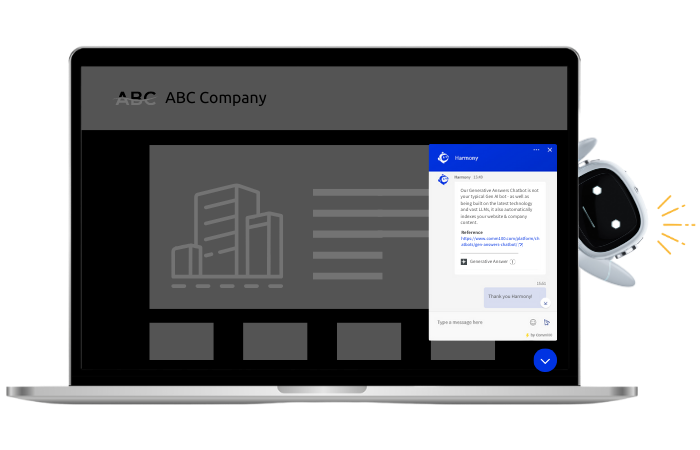
The AI Chatbot That Talks Like You
Automate over 80% of all inquiries. Launch in 1 day. Powered by the latest GPT and vast LLMs.

Before we dig in, let’s first be clear on what we mean by automated customer service. Customer service automation is the process of adding artificial intelligence (AI) into customer service operations to automate routine tasks and processes. Some of these AI tools are fully automated, meaning that customers receive a response without any human intervention. Other customer service automation may provide agents with AI tools to help them provide faster or more accurate support.
In customer service, automation is commonly seen in the form of chatbots. Chatbots can respond to customer queries, answering the common requests, immediately and 24/7. This speeds up support for the customer as they don’t need to wait for an agent to become available. With the common requests handled by a bot, it also reduces agent workload which can either increase support capacity or allow agents to spend more time on complex or sensitive queries – ultimately improving the customer experience.
Chatbots used as customer service automation tools include:
We’ll see examples of each automation in customer service later. Next, however, we’ll look at the state of automated customer service in 2023.

As the capabilities of AI have improved, the popularity of automated customer service has continued to expand. This has created new opportunities for organizations to reduce support costs while meeting the needs of today’s customers.
According to a study on chatbot impact, overall market preference for chatbots as the primary mode of communication for customer service now sits at 45%. The top markets currently profiting from chatbots include:
Chatbot usage has doubled since 2020, and is currently estimated to be worth $641.1 million USD in 2022. Many have also predicted the market to make huge gains in the years ahead, including growth of the global chatbot market to $3.99 billion USD by 2030.
In this chapter, we’ll look at developing trends in customer service and how we expect that will shape the landscape of automation in the years ahead.
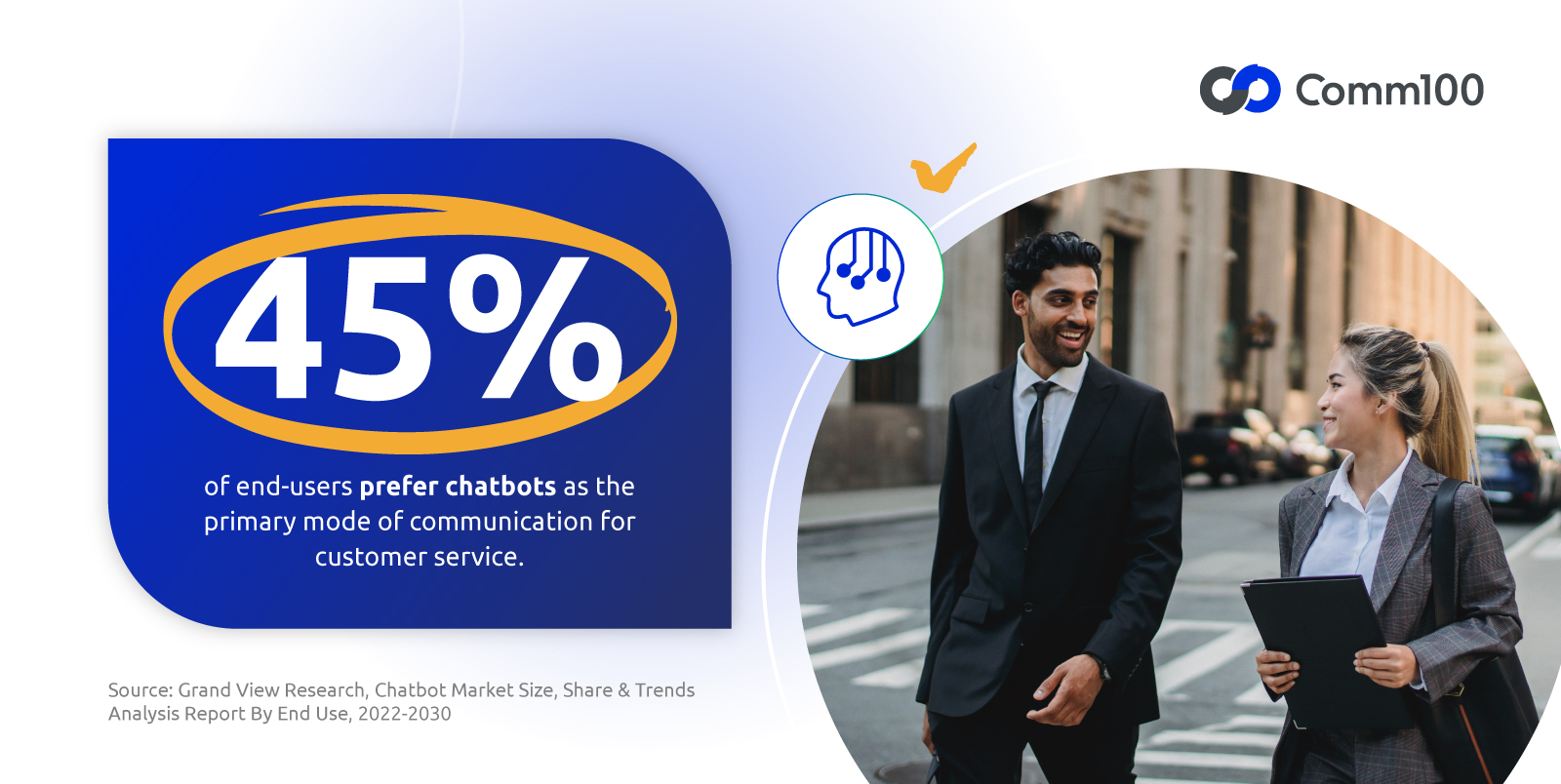
Much has been written about the difference in generational attitudes towards customer service. In 2023, we expect that age will continue to matter as customers expectations can vary wildly depending on preference for service delivery and availability.
In customer experience research sponsored by Amazon, we can see generational preferences in the customer service space emerge. Perhaps the most pronounced differences among generations came in attitudes toward digital self-service tools like chatbots. While just 14% of Baby Boomers say they prefer digital self-service, 49% of Gen Z and 41% of Millennials prefer to use a digital self-serve option.
Another 1000-person study found that Gen Z consumers prefer interactions with a chatbot at a rate four times higher than Baby Boomers. With such a pronounced difference in attitudes around customer service delivery, it’s important for organizations to provide a variety of service options to customers. Organizations should also understand who their customers are when developing their automated customer service delivery models.
The initiative for automation often begins with a desire to cut support costs but can see significant overall improvements in both customer and agent satisfaction. By automating simple, repetitive tasks, agent workloads are reduced, and job satisfaction improves. Research data increasingly shows that AI used responsibly can improve job quality for workers.
In research conducted by the non-profit organization Partnership on AI, employees were surveyed after experiencing AI in different workplace scenarios. Following constructive coaching and suggestions provided in real-time by AI, employees reported the suggestions were helpful for quality assurance. When AI was used to offload a tedious process, a strong majority preferred working with AI software over more manual processes.
A report by Forrester also showed high interest among workers and managers for the ability of AI tools to improve knowledge work. 51% of those surveyed believed that automation of routine tasks would improve employee satisfaction. More impressively 59% said they believed automation of mundane tasks would improve employee retention.
In a time of notoriously high employee turnover, it’s this last stat that may draw the most attention. With employees looking to offload their mundane tasks for better job satisfaction, additional research has shown that employee retention is directly related to the work employees are doing. 81% of employees say they’d be willing to work longer in their current position if their employer allowed them to focus on work they enjoy.
Providing personalized customer service has become a major differentiator for organizations, and for good reason. 80% of consumers surveyed say that they would be more loyal to brands that understanding them. Thanks to the introduction of AI in customer service, it’s now easier than ever to bring personalization to customers.
Introducing automation to customers doesn’t need to mean also losing a human touch. Without automation facilitating regular touchpoints throughout the customer journey, both customers and organizations benefit. An example of this is the automation of appointment reminders for patients in the healthcare industry. Missed appointments currently cost the healthcare industry an incredible $150 billion annually. With these appointments automated through SMS messages and automated calls, organizations can see significant savings, and patient outcomes improve through regular appointments.
While it can be challenging to best leverage the data collected through automation, the benefits are worth the effort. Harvard Business School has found that through personalization efforts of more than 100 leading global companies over the past five years, large-scale personalization efforts have resulted in increases of net revenues between 40% to 100%.
A key area where automation shines is in the ability to offer around-the-clock service. As customer expectations expand to include 24/7 availability, this has become a crucial aspect of automation in customer service. When customers were asked what customer service experiences they expect to be essential in the near future (3-5 years), 24/7 availability ranked the highest, at 57%.
The impact of 24/7 customer service is so significant that research suggests it is the key driver for the global chatbot market. As chatbots allow organizations to fully automate routine functions, introducing a chatbot extends beyond simple query resolution and allows organizations to offer new services to new customers. For industries like higher education, 24/7 service can greatly benefit international recruitment efforts targeting potential students in other time zones.

Automate over 80% of all inquiries. Launch in 1 day. Powered by the latest GPT and vast LLMs.

By automating routine tasks and providing immediate responses, AI can help organizations improve their support and meet customer expectations for speed and availability. In this chapter, we’ll explore the benefits of AI in customer service in detail.
Customer expectations have expanded, and 83% of customers now expect immediate engagement with someone when contacting a company, up from 78% in 2019. Additionally, 90% of customers surveyed consider an immediate response to be “important or very important” for customer support.
Only automated customer service can provide the kind of immediate support that customers now demand. Unlike human agents, chatbots respond to inquiries immediately and have unlimited capacity. Chatbots are ideal for responding to the simple but common questions such as:
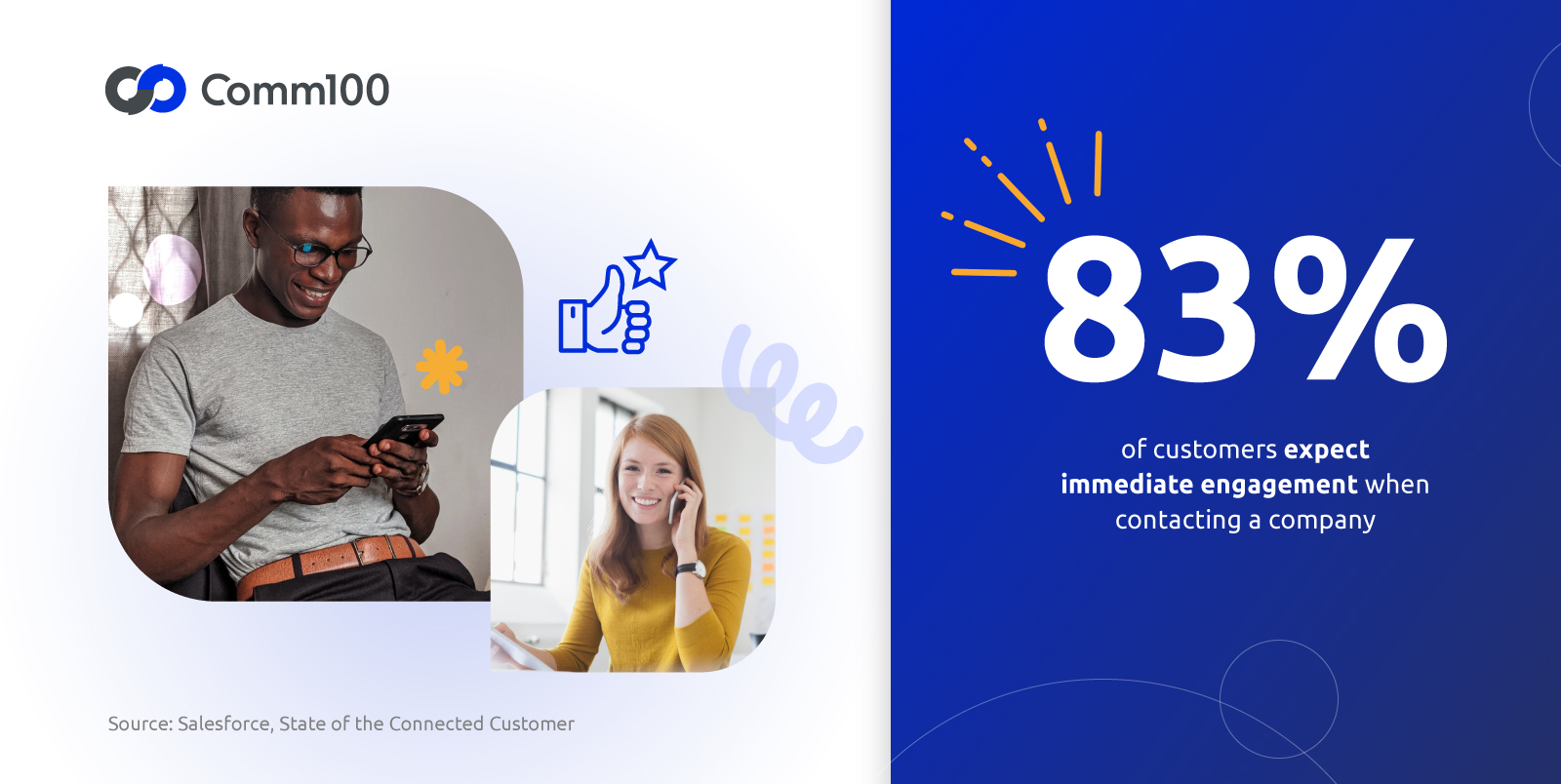
Today’s customers want 24/7 support that’s always available, whenever they need it. However, the expense associated with hiring additional staff creates a barrier for many organizations in their ability to offer 24/7 support. This is where automation in customer service can offer ways for organizations to meet customer needs.
With a chatbot providing automated customer service, customers can receive support at any time of the day or week – all without any human intervention. This 24/7 availability is so valued by customers that is drives 51% of positive willingness by customers to use chatbots, and 64% say that 24-hour service is the best feature of chatbots.
When a chatbot is unable to resolve an issue on its own, it can take a message so that agents can respond at their earliest availability. With automated customer service now offering a cost-effective way for organizations to offer around-the-clock support, it’s little wonder that 24/7 support is often cited as the key driver for the growth of the chatbot market.
Automation in customer service can generate a substantial return on investment for businesses. For example, Insider Intelligence estimates that the adoption of chatbots could soon save the healthcare, banking, and retail sectors $11 billion annually.
With a chatbot handling up to 80% of queries, organizations can increase their support capacity without hiring additional agents. Calculating the exact return on investment for automated customer service can be difficult, but this chatbot ROI calculator can help you understand just how much you could save with a bot.
It may seem counterintuitive that automated customer service would improve the customer experience, but not all customer interactions are the same. Chatbots excel at handling simple and repetitive requests and can resolve up to 91% of queries without human intervention.
When a chatbot handles the simple requests, everyone benefits: Customers with common and basic questions get an immediate response and resolution. On the other hand, customers with more complex questions experience shorter wait times and more agent attention as agents have more time to focus on their request.
Automation provides the best of both worlds: immediate responses to simple requests and better agent availability when customers need more attention. These benefits can be appealing to customers, particularly as 70% of customers currently use or are interested in using chatbots for simple customer service.
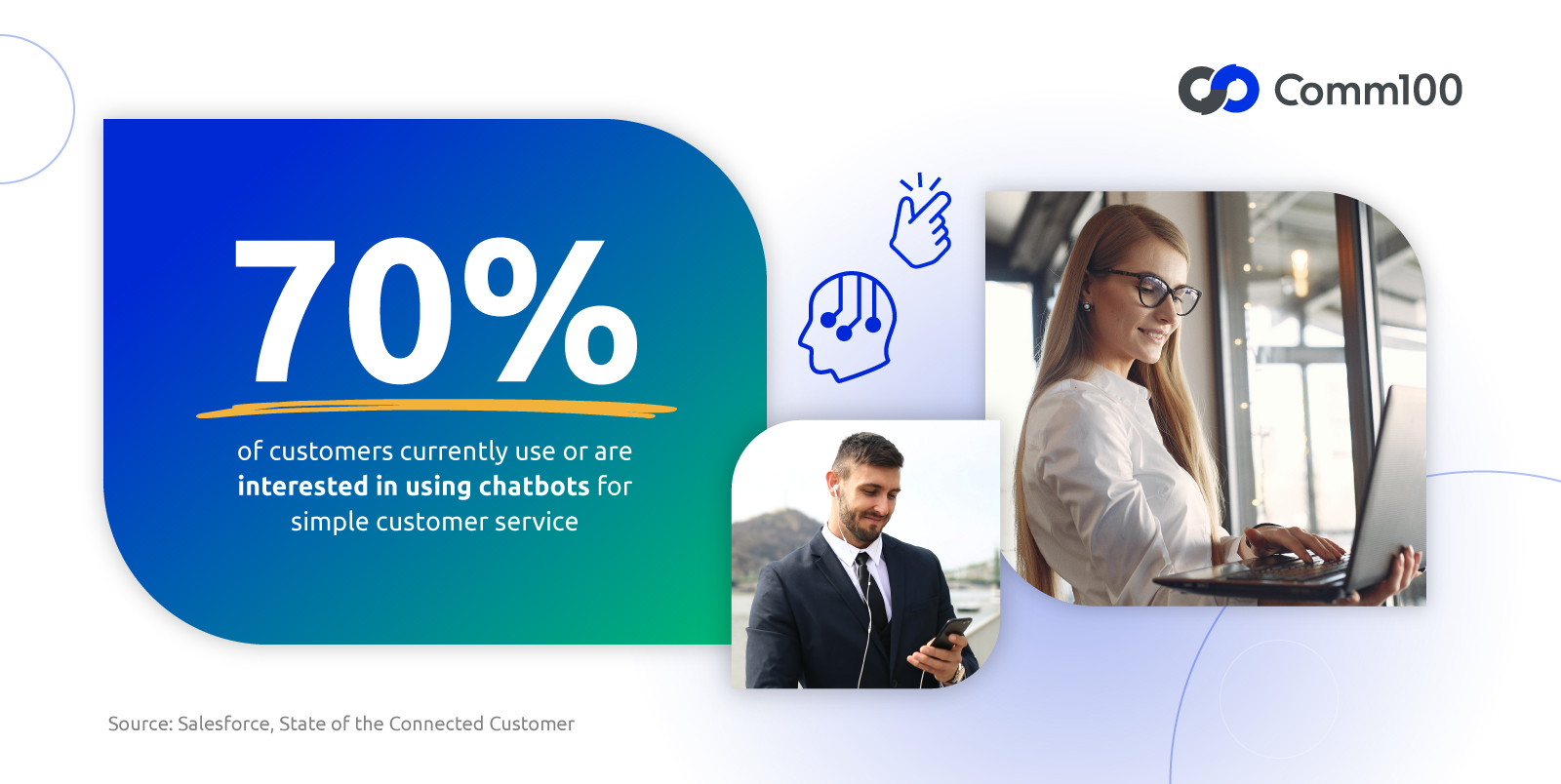
Customers often have difficulty finding information among various FAQs and knowledge base articles, and they may not have the time to speak with a human agent. For these customers, automated customer service is an ideal self-service option. In a survey of US citizens interacting with Federal agencies, more than 65% said they preferred self-service options over speaking with someone.
By introducing customer service automation software, customers can quickly find the information they need without the need to navigate complex support materials or wait for a response from a human agent. 90% of customers surveyed want a convenient experience when they interact with a brand online, and chatbots can provide that convenience by removing barriers to information.
Chatbots can have a major impact on the work of customer service agents. By automating repetitive tasks, chatbots free up agents to focus on more fulfilling work, which can improve their performance and reduce stress levels. When surveyed on the benefits of automation in completing day-to-day tasks, 68% of knowledge workers cited the ability to prevent employee burnout.
87% of contact center agents report high or very high levels of stress, and improving working conditions for these staff members is crucial to reducing turnover and improving overall performance. With the cost of hiring an employee estimated around $4,000 USD, reducing employee turnover should be a focus for every organization.

Now that we’ve seen the benefits of automated customer service, let’s look at specific examples of customer service automation software in use. In this chapter, we’ll look at how organizations are using chatbots to improve customer service across industries and use cases.
Perhaps the most common use case for customer service automation is in automating common questions with chatbots. In the best examples, AI chatbots can handle as much as 91% of queries without the need for human intervention
With agents free to focus on more complex issues, they can also improve the overall customer experience. A great example of this is Canadian Blood Services (CBS), which adopted Comm100 AI Chatbot to handle its most frequently asked questions.
After success with Comm100 Live Chat to connect with more digital-first customers, CBS saw an opportunity to automate the requests taking up the majority of their agent’s time. Following the introduction of Comm100 AI Chatbot, more than 70% of all live chat queries are directly routed to the chatbot, and of these, 68% are resolved without any human interaction.
“For us, the chatbot wasn’t launched to reduce agent headcount. It was launched so our agents can spend less time on simple queries, and more on the complicated and high-value queries.”
– Denny Michaud, Customer Relations Manager
Read more: Canadian Blood Services Improves Customer & Agent Experience with Comm100 AI Chatbot
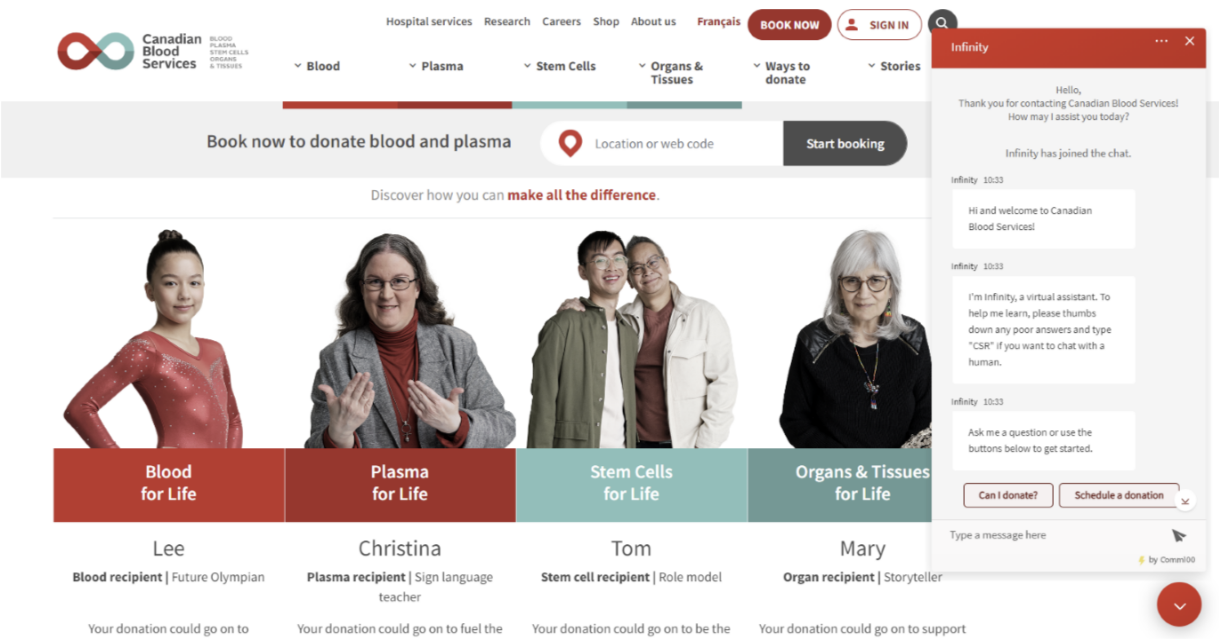
The next of our automated customer service examples is Task Bot. Task Bot can be a great way to capture leads from website visitors, expanding the reach of the traditional sales funnel. By prompting customers for contact details that can then be passed along to a sales team, Task Bot effectively automates traditional website forms.
In industries like healthcare, Task Bot can be used to book calendar meetings. For other industries, a task bot can be used to gather registrations for events. A task bot can be triggered by agents during any chat to offload routine work, allowing them to support a wide variety of use cases across industries.
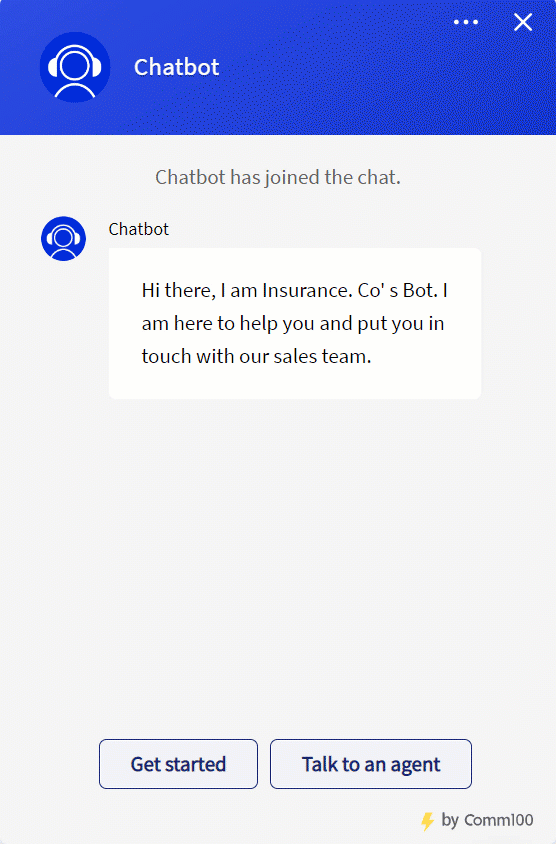
As we’ve seen, one of the best benefits of chatbots is their ability to provide 24/7 support at a lower cost than hiring additional agents. With a chatbot, companies can make sure customers get the help they need at any time of day.
Thompson Rivers University (TRU) is a great example of how chatbots can deliver 24/7 availability. TRU introduced Comm100 Live Chat in 2019 to provide students and faculty with quick and convenient support and saw immediate success within the Future Students team.
The university next worked with Comm100 to expand support hours beyond typical 9-5 business hours with the introduction of Comm100 AI Chatbot. Not only did their chatbot allow them to automate most common questions, it allowed TRU to offer 24/7 support to students. The chatbot now handles 83% of chats in the Future Student department without any human intervention
“I don’t have a computer science or programming background so finding a chatbot that was simple to build and code-free was crucial – and Comm100 Chatbot delivered on this. With a little learning and guidance from Comm100’s bot architect team, I built our bot from scratch with no technical knowledge. I think anyone who has a social media account can build a Comm100 Chatbot.”
– Lachlan Todd, Communications & Systems Coordinator, Thompson Rivers University
Read more: Thompson Rivers University Adopts Comm100 Live Chat & Chatbot Across 5 Departments
Our next example of automation in customer service comes from introducing a voice bot to digital voice and telephony channels. With a voice bot handling incoming calls, customer will begin receiving support immediately so that wait times are eliminated.
As with other kinds of bot, Voice Bot offers 24/7 support while keeping costs low. A voice bot can handle hundreds of topics and easily be trained to understand new topics and questions as needed. An example of a voice bot in practice could be a financial institution that provides a bot for customers to check their balance by phone.
The last of our automated customer service examples is the Agent Assist tools that providers like Comm100 offer. Agent Assist allows agents to take advantage of AI to respond to customers more quickly and with greater confidence.
Agents Assist takes the form of an AI-powered tool that monitors customer conversations for opportunities to provide support for agents. This includes answers to questions from the knowledge base, canned messages, and other chatbot intents. This creates a best case scenario that provides customers with the best, fastest responses while also leaving room for a human touch when needed. A typical use case for Agent Assist might be helping a new agent get up to speed as they learn about the product they support.
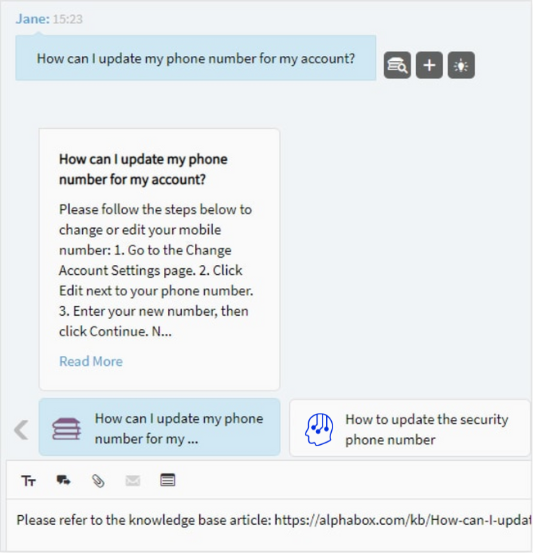
For more inspiration on how you can deliver customer service automation, take a look at the 5 most-used automated customer service examples that any industry can adopt.
If you’re ready to introduce automation in customer service to your organization, book a demo with Comm100 to learn more.
Comm100 helps organizations of all industries introduce AI into their customer service operations, helping them to provide:
Get in touch with Comm100 to bring the benefits of AI in customer service to your organization today.

Automate over 80% of all inquiries. Launch in 1 day. Powered by the latest GPT and vast LLMs.
There’s a lot more where this came from!
Get our monthly customer service news and best practices update delivered to your inbox.

Article by
Kate is the Content Marketing Specialist at Comm100. She has extensive experience in content creation for technology companies across the world, including the UK, Australia and Canada. She specializes in B2B messaging, branding and soccer trivia.